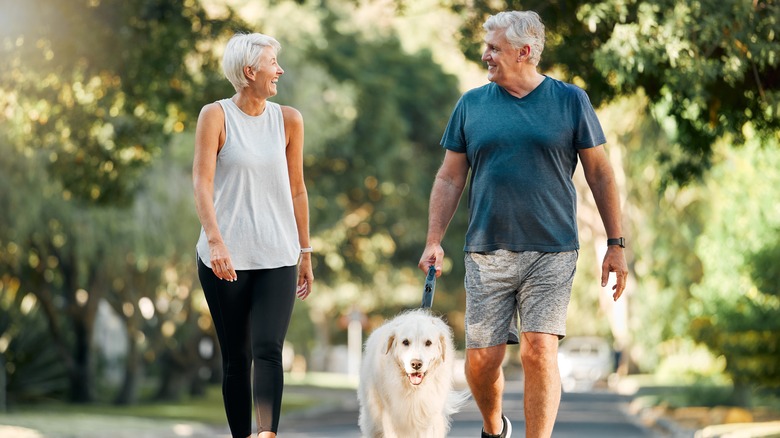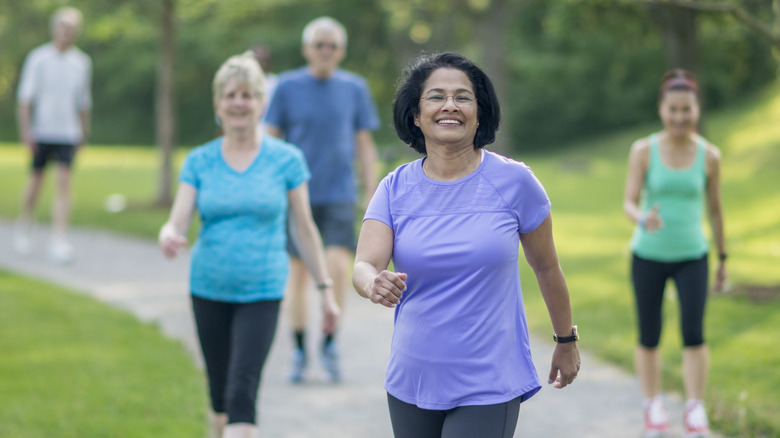Walking Backward Has An Unexpected Effect On Your Health
You've known how to walk since you were about 12 months old, but walking can be the perfect exercise to keep you healthy all your life. A 30-minute brisk walk most days of the week can keep your health in check by reducing your risk of chronic conditions such as type 2 diabetes, osteoporosis, and heart disease. Walking isn't just good exercise for older adults. It can be incorporated into your weight loss program, and walking up hills or at a faster pace can boost strength and cardio fitness (per Better Health Channel).
Don't assume that walking forward is the only way to get exercise. Walking backward — also called retro walking — can be more challenging physically and mentally because you're moving your body in ways it's not used to moving (per CNN). You're also using different muscles when you walk backward, and this can reduce pain and improve mobility. You might also find yourself burning more fat.
Walking backward can reduce pain
Walking backward is better for your knees because the knee doesn't have to move its full range of motion (per BBC). It can also reduce pain and functional disability for people with knee osteoarthritis. A 2021 study in the Bulletin of Faculty of Physical Therapy found that three days a week incorporating 10 minutes of retro walking with conventional therapy improved knee osteoarthritis after six weeks.
Retro walking might also be better for back pain than core exercises, according to a 2022 article in the International Journal of Scientific Research & Growth. Although both groups in this study did the same conventional treatment for back pain, one group did core stability exercises while the other group did retro walking for 30 minutes a day five days a week. After six weeks, the group that walked backward said they had less back pain. Retro walking can reduce back pain because it stretches the hamstrings (per BBC).
Walking backward improves mobility and metabolic health
Even though you learn to walk at a young age, you can lose your ability to walk as you get older. That's why it's important to keep moving later in life, and retro walking can improve your mobility, according to a 2023 article in the Journal of Coastal Life Medicine. The study had one group walk forward for 20 minutes three times a week, and the other group walked backward for the same duration. Four weeks later, the retro walking group had improved their walking speed and balance.
A 2023 study in the Journal of Taibah University Medical Sciences found that 12 weeks of retro walking can improve your metabolic health and reduce your body mass index (BMI). Men aged 18 to 25 with a BMI over 30 started walking on a treadmill for 15 minutes at 4 kilometers per hour at a 10% gradient. One group walked forward while the other group walked backward. The retro walking group reduced their BMI and waist-to-hip ratio more than the forward-walking group. Backward walking also significantly reduced C-reactive protein, which is a protein often associated with cardiovascular disease and inflammation. Furthermore, the lower BMI was connected with an increase in adiponectin, which helps your metabolic health by regulating your glucose and the breakdown of fatty acids.
How to start a retro walking program
Retro walking requires some degree of concentration and mindfulness at first because your body is challenged to move outside of its ordinary movement. You engage your hamstrings walking forward, but walking backward requires your quads to fire (per CNN). If you're starting a retro walking program, the main disadvantage is that you can't see where you're going. That means you have to rely on your feet rather than your eyes for feedback, according to Eldergym. Older adults might start at a wall and take 10 steps forward, then walk backward until they safely reach the wall.
You can try retro walking on the treadmill. Begin for about 10 minutes twice a week at a slow pace while holding onto the handrails. Be sure to stand up straight as you focus on each step. As you become acclimated to the movement, you can try to walk without holding to the handrails (per Access Sports Medicine).




